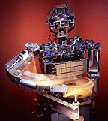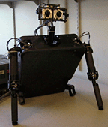



|
Project Overview
When a person gives a task to another person there are at least two
sorts of very human processes at work. At the surface level, each
person both displays and perceives cross-cultural cues which regulate
the interaction. Through facial expressions, body posture, and
utterances, the student unconsciously speeds or slows the rate at
which the instructor is teaching and directs the instructor to provide
more information when necessary. At a deeper level, the transfer of
information is successful because both student and instructor share a
common sense of how the world works. Both student and teacher share
not only knowledge about how objects behave (an intuitive physics) but
also knowledge about how other people behave (an intuitive
psychology). Our challenge is to make commanding robots as intuitive
and natural as commanding professional soldiers by providing a natural
and intuitive interface that capitalizes on a person's intuitive
understanding of how to communicate, and by instilling into robots
that same deep understanding of the world which is shared by people.
|







